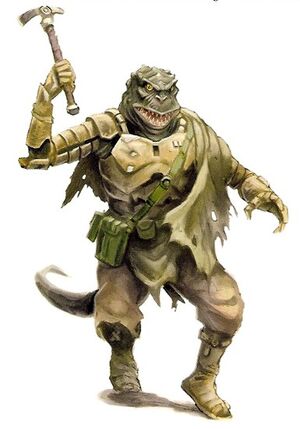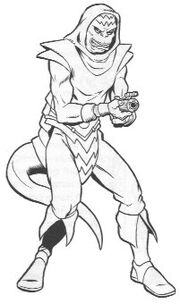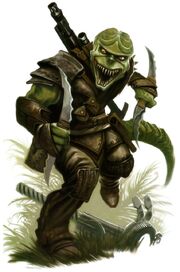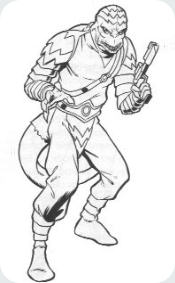
|
| Barabel | |
| General Information | |
|---|---|
| Homeworld | |
| Type |
Reptilian Humanoid |
| Diet |
Carnivore |
| Language | |
| Average Lifespan |
80+ |
| Physical Information | |
| Average Height |
1.9 - 2.2 meters |
| Skin Colors |
|
| Eye Colors |
|
| Abilities Information | |
| Force Sensitivity |
Average |
| Special Attributes |
|
| Societal Information | |
| Common Affiliations |
|
| Famous Exodus Members | |
Description[]
Barabel are a vicious reptilian species from Barab I with a hunting culture. On average, they stand 2 meters tall and weigh 130 kilograms. Jagged, overlapping, black keratin scales cover their bodies. They tend to be nocturnal, although they also engage in some daytime activity in their cave homes.
Barabel are famously mean-spirited. This normally manifests itself in direct physical confrontation, but Barabel have no qualms with property destruction, traps, indirect fire, or even crueler tactics. Outsiders sometimes confuse Barabel viciousness with stupidity. Though technologically primitive, Barabel are socially and economically adaptable. A Barabel trader will attempt to harm business rivals with rough negotiations in the conference room as zealously as she would rake with her claws in a fistfight. Barabel live in cave complexes that honeycomb the planet's mantle. Their homes are not complex, or even all that comfortable to non-Barabel. They live in rock homes decorated with skins, bones, shells, and various artifacts from a lifetime of hunts. They organize themselves by clans, and several clans form communities that occupy entire cave complexes. Leadership is generally determined by combat, but clan elders can mitigate a leader's influence, both formally and informally.
The largest communities have as many as 10,000 people, but most number in the hundreds. Individuals rarely travel farther than a hundred kilometers from their home in their lives. However, nearly every community has or knows of a Barabel who has left the planet to work as a mercenary or bounty hunter.

A female Barabel.
Communities remain in contact by hunting in overlapping regions and compete with each other by bringing back kills after each night's hunt. A community gives its biggest kill to the leader of another community who shares the hunting ground. The rival community might suffer the indignity of having to accept a greater kill, tacitly admitting the first community's greater power and prowess.
These nightly exchanges form a loose worldwide community in which prestige is gained through giving away the largest, most dangerous creatures found on any given night. No overt planetary government exists, but the largest clans have representatives in Alater-ka who have learned to negotiate with barbed rhetoric rather than pure combat.
Despite their reputation, the Barabel have learned from visiting Jedi and display impressive unity for such a vicious species. Hatchmates are closer than most Human families, and entire clans will declare war for a slight against one member. Of course, murderous fights still break out between individuals and whole clans, but the Barabel have generally learned to save their savagery for hunts or off-worlders.
Even years later, outsiders are still distrusted. Within Barabel memory, off-worlders have either hunted them or competed for good hunting. Non-Barabel are generally safe in Alater-ka, but traveling to another community or taking part in a hunt is an excellent way to get "accidentally" assaulted. Jedi who prove their station are treated deferentially, however, and can smooth over problems with a calm word and the flash of a lightsaber.
Abilities[]
The Barabel are the dominant species on a planet filled with fearsome predators and wildlife. They're fearsome warriors and born hunters, gifted with abilities that make them formidable in combat against any foe.

A young Barabel.
Keratin Scales[]
All Barabels are covered from head to toe in tough keratin scales. The coloration of these scales tends to start off as purple-green for younger Barabels, but they gradually turn to black by the time of adulthood. A rare recessive trait can also produce Barabel with red scales, as evidenced by Skahtul. In all cases, these scales are capable of providing excellent protection against standard melee weapons as well as low-powered blaster bolts. Stun blasts have no effect on Barabel because of their scales.
The scales also protect the Barabel in other ways as well. They were primarily developed to give the Barabel protection against the intense radiation that is given off by their sun. Although they aren't immune to heavy radiation, they're capable of surviving in it much longer than many other species.
Lastly, the scales work in conjunction with a layer of fat beneath their skin to trap heat. So, although Barabels are cold-blooded, they aren't prone to feeling sluggish like other cold-blooded species when in a cold environment.
Infrared Vision[]
Because Barab I orbits a red dwarf star that emits very little light, Barabels developed the ability to see in the infrared spectrum. Most Barabel also have a limited ability to see yellow in the visible light spectrum, but can't distinguish green, blue, or violet light. However, a rare few are born with eyes capable of seeing everything in infrared and the visible light spectrum.
Regeneration[]
Although their ability to regenerate isn't as potent as the Trandoshans, Barabels do posses a greater ability to heal wounds than other species. They've even been known to be able to detach their tails, if the need arises, and grow new ones.
Natural Weapons[]
A Barabel is a terror to behold in melee combat. They have teeth nearly two inches (five centimeters) in length and long retractable claws. In addition, they can use their tails as clubs to bludgeon foes who try to attack them from behind.
Two Stomachs[]
All Barabel have two stomachs, which allow them to gorge themselves and then go for days, and potentially even weeks or months without eating again due to their naturally slow reptilian metabolisms. The length of time between meals usually depends on how large the meal was and how active they are afterwards. In general practice, however, the few days timespan is the accepted norm.
Meld-Fighting[]
This unique form of battle meditation was developed by Force-sensitive Barabels. When a group is connected via the meld-fight technique, a single being focuses the concentration of all members in the meld, giving them all an incredible cohesion of effort. According to Jedi studies, Barabel have a greater connection to the unconscious and subconscious parts of their brains than other species like Humans.
Society[]
Barabel society is ruled by clan life. Although they have no formal government, the most powerful and prestigious clans often decide important matters for the entire planet. If a clan is completely wiped out, it is a common Barabel custom to never mention the clan by name again. This is done either out of respect or for fear of putting a curse on their own clan, depending on how and why the clan was destroyed. Only historians and storytellers can ignore this taboo without fear.
Due to the race’s noted hunting and tracking prowess, many of their actions are fueled by their hunting instincts, leading to the general feeling that Barabels are always angry, or in the very least ornery. They are well known for their aggression but conversely are also extremely loyal to their mates and parents. Despite their moral nature, they frequently enjoy ending up in fights and will often do so with little to no provocation. They usually do this not because of grudges or perceived slights, but because they like to test themselves.
Apologies, whether for a misdeed or in sympathy, are an altogether foreign concept to most Barabels and considered to be a sign of weakness. It is considered mildly insulting to a Barabel to be apologized to and apologizing tends to actually make a situation worse than simply saying nothing would. This is sometimes disconcerting for members of other species, especially Humans, when they feel the need to apologize to a Barabel or fail to receive one from a Barabel.
Barabels are known to express emotion—such as amusement or grief—by "sissing," which is basically a modified hiss repeated for effect.
Prestige[]
Gaining prestige for one’s self, and by extension their clan, is usually an important factor in every Barabel’s life. Prestige can be gained in any number of ways, but usually centers around combat in some form. A Barabel’s skill in battle or the hunt is the most common method of gaining prestige, but effective leadership or somehow bettering the Barabel people are also counted.
Often the most prestigious Barabels are those who have left the planet. The clans attempt to keep track of every Barabel that leaves Barab I in order to see how they affect their clan’s prestige.
Barabels lose prestige by acting cowardly and otherwise showing weakness to others. Dishonesty and manipulative behavior, while not necessarily a detriment to prestige, can drop prestige if the Barabel chronically abuses it.
Known Barabel Clans[]

A male Barabel.
- Akili - Run by a large male named Grazarg, the Akili are known to consistently come away from the nightly hunts with the best kills. Akili Barabels are also known to be aggressive, even for their own kind.
- D'rek - Barabel in this clan are known be consistently larger than other Barabels. The D'rek used to be the head warrior clan on Barab I, but were ousted by the Surax. 'Rurk A'Tarak is a member of this clan.
- Kular - One of the most prestigious clans on Barab I, the Kular are a small clan but its members are very skilled. It is run by a young female named Loranol, daughter of Rashrak.
- Reka - Reka is notable for having the most Barabel offworld compared to any other clan. A female named Seji Seb runs the clan.
- Relhig - The Relhig have the honor of being one of the oldest clans on Barab I. The Relhig are often looked to for their wisdom and are known to keep the most extensive records of Barabel history. An elderly female, Yaz Divso, currently leads them.
- Surax - One of the largest clans on Barab I, the Surax are always involved in all matters pertaining to the Barabel people. They are very careful to maintain their influence and will often attempt to crush their less prestigious rivals through combat or poltical manuvering. A cunning and heavyset Barabel named Korshank has been in charge of the Surax for decades.
Dead Clans[]
- Kuraak - The Kuraak were wiped out by Hutt-controlled slavers. Despite overwhelming numbers and the technological superiority of the slavers, the Kuraak fought to the very last member and dealt heavy casualties to the slavers. In the end, the slavers were only able to make off with one young Barabel, Skarrek. The Kuraak are remembered in stories and revered by other Barabel as a great clan.
Naming Scheme[]
Barabel names can either be one name or be composed of a first name and a last name. There seems to be no reason why some Barabels have last names and others don't. It is often theorized that some Barabels adopted last names after their first contact with the Jedi and is an attempt to emulate them.
- Male Names - Baraduk, Berrann, Drif Lij, Fivvic, Glamaxon Tvurl, Rashrak, 'Rurk A'Tarak, Skarrek, Tesar Sebatyne, Tibor, Tull Raine, Yarrku
- Female Names - Bela Hara, Krasov Hara, Kursma, Reswa, Saba Sebatyne, Shaka-ka, Shallamar, Skahtul, Slizzik
Terms[]
All species have certain terms that are frequently used within their culture and the Barabel are no different. Here are some of the most common.
- Blights of Barabel - A mythical or legendary group of demons from Barabel history, they are often called upon to bring a curse to another individual.
- Hungry One - The Barabel god of destruction. According to legend, the Hungry One exists in all Barabels, but is dormant unless provoked to awaken when an individual goes into a killing rage.
- Hunt-glee - Used to describe the enjoyment a Barabel finds in pursuing and capturing its prey.
- Longfang - This is the Basic translation of the Barabel term for the leader of a pack or family group.
- Shorttail – A Barabel insult. Most Barabels pride themselves on their tails, and to infer that a Barabel's tail is short is considered exceptionally demeaning by them.
- Skulo - A Barabel expletive, used to describe someone who is either crazy or stupid, or perhaps both.
- This One – A term commonly used by some lone Barabel to refer to themselves instead of using personal pronouns like I or me. The usage of this term tends to disappear when Barabel are in groups of their own kind. It should also be noted that not all lone Barabel use this term and it can vary by individual.